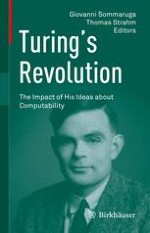
2015 | OriginalPaper | Chapter
Conceptual Confluence in 1936: Post and Turing
Authors : Martin Davis, Wilfried Sieg
Published in: Turing’s Revolution
Publisher: Springer International Publishing
Activate our intelligent search to find suitable subject content or patents.
Select sections of text to find matching patents with Artificial Intelligence. powered by
Select sections of text to find additional relevant content using AI-assisted search. powered by